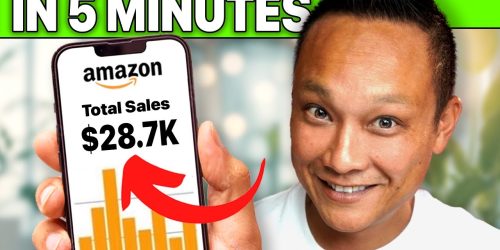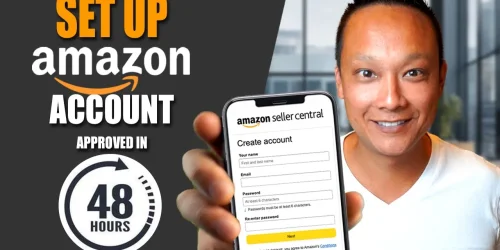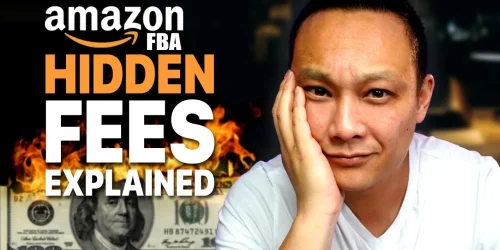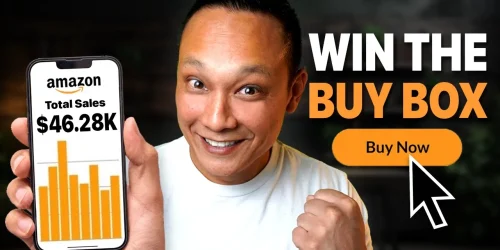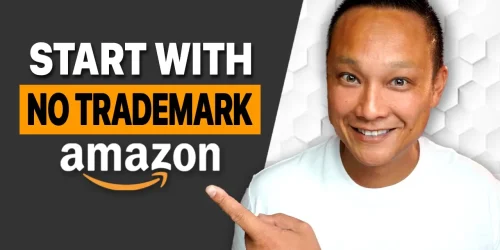How to List Your FIRST Product on Amazon FBA & Mistakes to Avoid New Workflow Step by Step Tutorial
What’s up guys, my name is Crescent. So, before we start, I want to point out that creating your product listing on Amazon should be one of the very first things that you do. You don’t want to leave it to the end. You don’t want to invest a ton of time and money into a product, then go to create your product listing on Amazon, only to find out that the product itself is prohibited or you’re not allowed to sell on Amazon. So hopefully, you’re not currently in that boat.
Now, listing your first product to sell on Amazon can be daunting and quite confusing and there’s also a lot of misinformation out there. And on top of that, Amazon recently changed the add a new product listing tool, so in this video, I’m going to clear all of that up and show you how to list your very first product to sell on Amazon step by step from beginning to end whether you doing FBA or FBM using the new system. And speaking of doing things first, smash that like button for the youtube algorithm! If you enjoy videos like this or you find value in this information, it really does help out the channel enormously, more than you know and I would really appreciate it, so thank you! And with that said, let’s get started.
So the first thing you need to do if you haven’t already done so is create your Amazon seller account. Now, if you plan to sell on the US amazon marketplace, then you can create your seller account on amazon.com, otherwise, if you plan to sell on another marketplace such as the UK, then you’ll need to create your seller account on amazon.co.uk or what have you. Now, one thing to note, generally seller accounts are grouped by continent, so if you create a seller account on .com, then that one seller account gives you access to sell in the US marketplace as well as on the Canadian and Mexican marketplaces too.
Now, most beginners don’t realize that when you create your seller account that you actually have two options, the individual seller account and the professional seller account. And pay attention here, this bit is confusing for some people. These two account types have nothing to do with whether or not you are selling as an individual or as a registered business. I’ll go over that later on in the video. Now, the difference between the individual seller account and the professional seller account can be seen here. The biggest difference is that the individual account is free, however, with each sale that you make, you have to pay a $0.99 fee on top of the seller fees, whereas, with the Professional seller account, it costs $39.99/mo plus the seller fees. So, as you can see, if you sell more than 40 items per month, it’ll end up being cheaper to go with the Professional seller account. You also get access to more advanced features as well as advertising and marketing options with the Professional account. But if you’re just started out though and you want to save some money, you can always start with the Individual account to get your feet wet and you can always upgrade to the professional account later and vice versa.
https://sell.amazon.com/pricing
Now, Amazon has recently started getting more stringent with approving new seller accounts to help prevent bad sellers from getting onto their platform. So when creating your seller account, make sure you have all of your personal details and banking info handy and if you’re going to sign up with your registered business, have all of your business details on hand so that you can get through the sign up process as easy as possible. Amazon will require you to go through a verification process to confirm your identity before approving your seller account and some people have been having problems with this, so I actually leave a link to a very detailed video that goes over how to register your new seller account with out getting rejected during the verification process. It goes over what info and additional documentation you need to provide as well as how to submit them properly. I’ll leave a link to that video in the video description below.
Now moving on. Once you have your new seller account approved, in order to list your first product, you’re going to need a GTIN or UPC barcode. Now, if you’re doing Arbitrage or wholesale then your product will already have a GTIN or UPC barcode on it that you can use. Those are the barcodes that the cashier scans at the checkout counter. Otherwise, if you’re doing private label then you’re going to need to buy a GTIN or UPC barcode. If you need to buy one, what I suggest is only buy your barcodes directly from gs1.org. Amazon actually requires that all barcodes are GS1 certified and as you can see here, Amazon will actually verify that the barcode is authentic by checking it against the GS1 database. If it isn’t, you can have your listing suspended or selling privileges removed. Now in the past, a lot of sellers have been buying their barcodes from third-party resellers like barcodes Mania or speedybarcodes because they were a lot cheaper at around $10 each, whereas GS1 barcodes, you used to have to buy a package of 10 UPC barcodes for $250 plus an annual fee. However, GS1 has lowered their price. You can now buy UPC barcodes individually for $30 each with no annual fee. So, as you can see, it’s not worth the risk of buying from a 3rd party now. Just buy directly from GS1. I’ll leave a link to the GS1 barcodes in the description below.
GS1
https://my.gs1us.org/product/1367/gs1-us-gtin
GTIN requirements
https://sellercentral.amazon.com/gp/help/external/200317470
https://sellercentral.amazon.com/gp/help/external/LE2KYT2UVPMTYGS
Now another common question I get asked all the time is how many barcodes do you need to buy? Well, the simple answer is every unique product or variation will need its own barcode. All products that are the exact same will have the same barcode on it. For example, let’s say I’m selling this blue plush Like pillow. If I’m only selling this pillow, then I only need to buy one barcode and this barcode will go on every one of these pillows. It doesn’t matter if I’m selling 10 or 10,000 of these pillows, the same barcode will go on every one. However, if I’m also selling a red version of this pillow, then I’ll need two barcodes. One for the Blue version and another barcode for the red version. All of the blue pillows will have one barcode them and all of the red pillows will have the other barcode on them. Makes sense? If you want to learn more about how barcodes work and how to label your products, I’ll leave a link to a video that goes into detail on this in the description below.
Alright, now that you have your barcodes purchased, we can move on to listing the product on Amazon. Log in to your seller central account and click on Menu > Catalog > Add Products. Or Inventory > Manage Inventory > and at the Top Right > Add a Product button
Now, if you’re doing wholesale or arbitrage, your product is going to already have a barcode on it so you can enter the UPC barcode in the search here or you can type in the product keywords and the search results will pull up similar products for you select the correct listing for you to sell your products under. Selling on Amazon is unlike eBay where everyone creates their own listing for whatever item they’re selling. On Amazon, all products that are the same must be listed under one listing. So if your doing wholesale or arbitrage, the product you’re selling most likely already has an existing listing on Amazon so you’ll have to list your units for sale on that listing.
Now, most of you here are probably doing private label so you’ll have to create a whole new listing. So don’t use the search, click the link below that says “I’m adding a product not sold on Amazon”. Now, the first thing you need to do is select the category your product falls under. The easiest way is to use the search field here and type in the product you’re selling. You can also choose the category manually from the list here. If you don’t know which category to choose, you can find the correct category by looking at a competitors listing. Just scroll down and you can find the category here. Then you can manually select the category here. If you see several categories options, just choose the one that best fits your products.
One thing to note, some products are prohibited or have restrictions in order to sell them on Amazon. With prohibited products, you can’t sell them on Amazon period. So make sure you find out ahead of time before you invest any money on inventory. Restricted products may need approval before you can sell them. Some products fall under gated categories. That means you need to apply for approval in that category before you can sell products in that category. Many of these gated categories are easy to get approval for, you just have to answer a few questions and you’ll get instant approval. Others may be more involved and will require you to submit invoices or certifications. It’ll tell you what you need if you need them. You can see what the requirements are on this list. Keep in mind, some main categories that are not gated may have subcategories that are gated.
Also, some products must meet specific compliance requirements or certifications in order to sell on Amazon such as hazmat, FDA or CPC certifications. Amazon actually just released a new compliance tool to make it easier for sellers to check if the product has any of these requirements. I’ll leave a link to this new tool in the video description below but it’s actually really simple to use. Just do a search for the products keyword and the tool will tell you what requirements are necessary for you to sell it on Amazon. For example, if you want to sell baby pacifiers, you can see that it says you need to have the following requirements. CPSIA as well as these certifications. Test reports that meet CPSA section 14 a5. A childrens product certificate or CPC. As well as a Test reports from a CPSC-accepted lab. Also be aware that if you don’t find your product using the tool, it doesn’t necessarily mean that there isn’t any requirements. Make sure you refer to the prohibited and restricted products pages as well as speak to a Seller Support agent to verify. Always do your due diligence.
Product Compliance
https://sellercentral.amazon.com/help/hub/reference/200301050
Compliance Tool
https://sellercentral.amazon.com/help/hub/reference/G2JX2MAWJ27DWAY6
https://sellercentral.amazon.com/ckp
And last, products that are patented or trademarked will require you to get permission from the IP owner in order for you to sell. I personally suggest avoiding patented and trademarked products. Again, I’ll leave links in the description below if you want to learn more about these restrictions and requirements.
Moving on. The first page you’ll see here is the Product Identity tab. We’re going to have to fill in some information on this page but before we do, I want to point out that, as a bare minimum, you have to fill in all of the required fields in order to save the new product listing. You’ll notice that the save button is dimmed and you can’t click on it. That’s because we haven’t filled in all the required information. All the fields with a star or highlighted in red need to be filled in. Also, if you see a red exclamation mark icon on any of these tabs here, then there is incorrect or incomplete information that you need to fix on those pages too.
And take notice of these messages here. If you’re doing wholesale or arbitrage, this first message is letting you know that all sellers of the same product that are on the same product detail page, Amazon will combine and present the best product data to ensure customers get the best experience.
And like I mentioned earlier, Amazon upgrade the Add a new product listing workflow tool, so this message is just informing us of the update.
Alright, so the first field is the product name. This is the listing title. The title is what you see when you’re searching to buy something on Amazon. You’re going to want to make sure you’ve done your keyword research here before you create the title to make sure that it’s keyword optimized. If you haven’t done that yet, then you can just enter a temporary title for now and edit it later. I do have a video that goes over how to do keyword research and I’ll leave a link to that in the description below.
Alright, next is the Brand Name/Manufacturer. If you’re doing private label then you are the manufacturer so put your brand here. It doesn’t matter if you have a registered trademark or not. If you don’t have brand name, you can just make something up. It can be your name or anything else meaningful to you. If it’s already taken on Amazon, you’ll get an error message and you’ll have to choose a different name. If you don’t want to sell under a brand, then you can put generic or just N/A here. Now, one thing to point out here is that if you don’t have a registered trademark, you can run into an error when you enter your brand name. This is typically an error called the 5665 error and it’s because Amazon wants to verify your branding ahead of time by getting brand approval first to avoid IP violations and counterfeit products etc. So if you run into this error, I do have a video that goes over how to get around it and I’ll leave a link in the video description below.
Ok, now the next field is the Product ID. Here’s where you’re going to enter the barcode. Then choose the barcode type. If you purchased the barcode from GS1, you most likely purchased a UPC. Take note that there’s a lock icon here. Once you enter this and save this product listing, the barcode can not be changed or reused again on another listing. Now, f you bought an EAN barcode and you’re getting an error here, check to see if the barcode number you have is only 12 digits long. If so, then you may need to add a zero to the beginning since EAN barcodes need to be 13 digits. If you’re getting any other error such as the barcode doesn’t match or isn’t found, then if you just bought the barcode from GS1, you may have to wait 24-48 hours for the GS1 database to update before using the barcode on Amazon. If it’s been longer than 24-48hr, then contact a support agent to help you. Now, if you want to learn more about barcodes, which type of barcode you need to buy, how many, where to buy them from and where do you need to use them, I put a link to a very detailed video in the description below.
Now, at this point if you need to stop, you can click on Save as Draft and you can come back later to finish the product details. Otherwise, Click on Continue. Click on next.
Now, you can see that we’re on the Vital Info Tab and that there’s required field we’ll need to fill in on these other tabs.
So, first things first, the fields you see from this point forward may look different than what you’re seeing when you create your new product listing. The fields can change depending on the type of product and category it falls under.
Ok, so the first field here is the Item Type Name. If at anytime you don’t know that the field is asking for, you can hover your mouse over the question mark and you’ll see a tip pop up. So in this case, we need to enter a one or two word phrase that describes the product. If we click in the field, you’ll notice that some auto complete options pop up that we can choose from to make things easier. So, in this case, lets choose Throw Pillows.
Alright, the Model Number and Model Name. These are for your own bookkeeping purposes so just make something up. I like to make it somewhat descriptive so I can identify what it is. For example, for the model number, Like-Pillow-Blue. If there’s different sizes, then I might add -LG or -Sm to the end of it. You can use whatever method works for you. And for the Model Name, I generally keep it the same. And again, if you’re doing private label, the Manufacturer is you, so put your brand name here. If you’re doing wholesale or arbitrage, put the manufacturers name here.
Alright, now let’s click on the Offer Tab. What I suggest doing first is hopping down to the Fullfillment Channel open and choose if you’re doing FBM or FBA. This is because the fields will change depends on which option you choose. So, in our case, we’re doing FBA so choose Amazon will ship and provide customer service. Alright, so as you acn see, some of the field disappeared.
If you’re doing FBM, the quantity field is how many units in total you have available for sale. And the Merchant Shipping Group is how you’re planning to ship the product. You’ll have to create templates for this.
Now, you don’t need to enter anything in to the first field, just leave it blank. In Your Price field, I suggest setting this to the highest price you imagine ever selling the item for. This is so if you ever need to change the price or raise it significantly, you won’t lose the Buy Box. Then, in the Sale Price field, which we can’t see right now and I’ll go over later on in the video, you can set the price to the actual price you want to sell the item for. This way, for some products and categories, when you look at your listing, it’ll actually show the higher price with a line through it and show the sale price next to it, which can help with conversions.
The condition type, select New. If for whatever reason you’re selling a item that isn’t new, then select it from the list.
If you want to sell your product in other marketplace, you can set the price here. Keep in mind, if you plan to do this, the fees are much higher, so make sure you’ve adjusted your sale price accordingly.
Ok, moving on to the Product Details tab, here’s where you can enter the description and bullet points for your product listing. In the description section, you can enter any additional details of your product that you didn’t already mention in the bullet points or show in the product photos. Or anything that you just want to highlight again such as the product dimensions, weight, color, or material. Or if it requires any special instructions, you can put those details here. Try to cover all the details and questions a buyer might have so you can make the buying decision easier with the least amount of resistance. Another pro-tip here is don’t put everything you want to say into this one field. If you do, all the text will be in one giant paragraph like you see here.
If you hover over the question mark, you can see that it says the information will appear in paragraph form. So, break up what you want to say in to meaning full paragraphs and enter them separately by clicking on Add more. You can add up to 5 paragraphs. Now, once you save your listing, you’ll see that it’s much nicer and easier to read.
Now, if you have a registered trademark and you applied for and got approved for Brand Registry, you can create a much more content-rich product description. Instead of just few text paragaphs, you can create a beautiful theme with images like you see here.
I highly recommend registering your brand and applying for Brand Registry as it not only gives you access to A+ content but you also get a ton of benefits such as brand protection.
https://brandservices.amazon.com/
Ok, now the bullet points. The bullet points is the section you see at the top of the product listing here. You can add up to 5 bullet points. Just click on Add more. A pro-tip here. I see a lot of sellers just putting some generic product features in the bullet points. Don’t do that. Really put some thought into choosing 5 key benefits your product has. How is your product uniquely solving a problem that the buyer has? What is your product’s competitive advantage? Don’t just put something generic that doesn’t help sell your product. Basically, a test I use is if I can take my bullet points and place them on competitors listing and they apply to their product, then it’s a bad bullet point.
Alright, Generic Keywords. Here’s where you can add a list of relevant keywords you want Amazon’s A9 algorithm to index for the search. Keep in mind that, as I mentioned at the beginning of this video, you should do in-depth keyword research to put together a list of highly targeted keywords for your product that you can use in your title, product description, bullet points, and this keyword section. How to do that is beyond the scope of this video but I’ll leave a link to a video in the description below if you want to learn more about how to do keyword research. Keep in mind that you are limited to only 250 characters here. So, what you should do is enter a list of keywords that you haven’t already used in your product description and bullet points, there’s no need to duplicate any keywords, you’d just be wasting the limited space you have available. And one thing to note, if we hover over the question mark, it says “No repetition, no competitor brand names or ASINs.” So, make sure you’re not using any other sellers’ brands or trademarks here as well as any of the other prohibited keywords that you can see here in the guidelines. Again, the video on keyword research goes over this in detail if you want to learn more about it.
https://sellercentral.amazon.com/gp/help/external/G23501?language=en_US
Alright, now most of these fields are going to be specific to the product or category, so I’m not going to go through them all, but a few you want to take note of is the Number of Items field. This is how many of the same item the buyer is getting. In this case, if they are just getting one pillow, then put 1. If it’s a 4 pack of pillows, then put 4.
The Part Number is again for your own book keeping purposes. You can put whatever you want here. I just put the same as the model number as it suggests here.
Ok, and moving on to the Safety and Compliance tab. Here’s where you’re going to fill in any compliance requirements your product needs to have. You need to make sure you’re answering these correctly. The Compliance tool I went over in the beginning of this video will tell you what the requirements are.
So again, what you see here may be different for your product. So, where is your product coming from? In most cases, they are being manufactured in China. In this case, there are no batteries. These pillows are not considered Dangerous goods or contain any dangerous or hazardous materials. Again, you can get more information by hovering over the mouse. It doesn’t require any product compliance. This is also not applicable. And no warning applicable.
Ok, and now on to the Shipping tab. Here’s where you’re going to fill in the size and weight of your product. You can get this information from your supplier. This isn’t the size and weight of your entire inventory shipment that you ordered from your supplier. This is the size and weight of one individual item. These dimensions is what your FBA fee will be based on.
Alright, so now all the of required fields in the required tabs are done and you can click on Save and Finish. Now, if the Save and Finish button isn’t clickable, then you have invalid details or incomplete fields that you need to fix before you can save the listing. So, if you can’t click on the Save and Finish button, look for any highlighted fields that are red, or any tabs at the top that have a red exclamation mark.
Ok, so before finishing up, let’s take a look at the Images tab, here’s where you’re going to upload your product photos. Now, I can’t stress enough how important it is to get professional photos taken. Just because you have a nice camera or you know a friend that has one, doesn’t mean they are experienced product photographers. The quality of your photos alone can determine the success of your product. Professional photos aren’t that expensive and typically cost from $75 to $300 range. You can find really good photographers on fiverr.com or even look for one locally. I have a video that goes into detail on to get the best professional photos and I’ll post a link to it in the video description below.
Now, if you don’t have professional photos yet to upload, you can always upload a temporary photo for now. In fact, it doesn’t even have to be a photo of the product you’re selling. You need to upload at least one image in order for the listing to go live once you have inventory. But be aware though that if you decide not to take your own photos, that you don’t inadvertently use someone else’s photos. That means be careful using some random photo on Google, it may be copyrighted. And don’t steal a photo from a competitor. Use common sense, violating someone’s intellectual property is a serious offense and you can have your listing shut down, selling privileges revoked, or worse, you can get sued. So don’t use copyrighted material on your listing.
The photos upload also need to meet Amazon image requirements. For example, Images must accurately represent the product that is for sale. Images must match the product title. MAIN images must have a pure white background. MAIN images must not include text, logos, borders, color blocks, watermarks, or other graphics over the top of a product or in the background.
https://sellercentral.amazon.com/help/hub/reference/1881?ref=efph_1881_cont_43381&locale=en-US
Make sure you follow these guidelines, otherwise your listing will be suppressed until you resolve the issues.
Ok, and now the Variation tab. Here’s where you can enter variations if you have any. Here’s a pro-tip, if you think you’re going to sell variations of this product in the future, I suggest setting up at least one variation now and just not use the variation until you need it. Otherwise, trying to convert your listing to include variations in the future is much more difficult which usually requires you to use a flat file. In this case, you can see that variations are not available for this category. In this case, if you do have variations, you won’t be able to use this add a product tool workflow to add them. You’ll have to download a flat file, edit it with the products and variations and then upload it. How to do that is beyond the scope of this video but I’ll post a link to how to do it in the description below.
And now, the last step and a very important one, once you’ve saved the listing, you can now download or print the FNSKU barcode label. You need this barcode label because it needs to go on each one of your products. You’ll need to send the label to your manufacturer so that they can put it on your product for you. You can download or print it by going to the Manage inventory > click on the drop down > Print Item Labels. Now, if you’re wondering how you can print and even customize the barcode label so it has more info on it like any warnings you might need to have, the country of origin, or just to make it look nicer to fit with your custom product packaging, I’ll post a link to the video in the description below that shows you how to do that.
Now, remember, if you’re doing private label, the listing you created is yours. You have control over the listing and all the info, details and photos in it. So, if you need to make any changes to the product listing, you can click on the Edit option here and make those changes any time you want. Just keep in mind that sometimes it can take 15min to 24 hours for any changes you make to take effect, so if you don’t see your changes after 24hr or if you’re having problems trying to edit your listing, contact Seller Support.
And if you notice, on this product there’s now a Sale Price field that I mentioned earlier for setting the actual price that you want to sell your product for. Set the Your Price to the highest price you’d ever imagine you’d sell it for. Then set the Sale Price to the actual price you want to sell it for. Then set the start date to sometime in the past and the end date to some time way in the future. This way, in some cases, you’ll see the higher price crossed out in red with the lower sale price next to it like you see here. And by doing your pricing this way, it’ll help prevent losing the buy box. Again, you can find a link to how to price your product so you don’t lose the buy box in the description below.
And lasly, a couple bonus tips for sticking around to the end. First, I suggest always turning on the Gift Wrap option. This way if someone wants to send your product as a gift, they can. And second, I also always suggest setting the Max Order Quantity to something other than 0. Leaving it at 0 means someone can buy as many units from you as they want. You might think why would you want to stop someone from doing that? Well, I’ve seen this happen way too many times where you create a promotion, coupon or sale and don’t set it up correctly where it only applies to one item or that it can only be used once and a buyer will use that coupon and wipe out a seller’s entire inventory for pennies. So, make sure you set this field to something other than 0.
Alright! Now you’re ready to create your first product listing! So if you want to get in touch with me, you can find all of my contact details in the video description below. I’d love to hear your thoughts, so leave a comment or question in the comment section below, I answer every single one.
And as always, if you found value in this video, consider subscribing. And do me a favor smash that like button for the youtube algorithm it really does help me out and I’d appreciate it, and ring the bell so you never miss a future video! Alright, thanks for watching!

